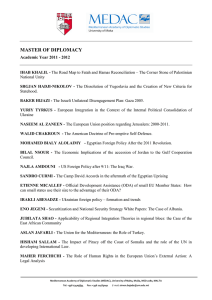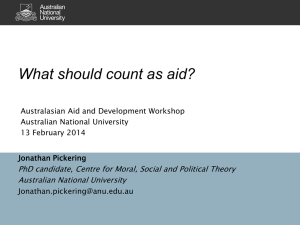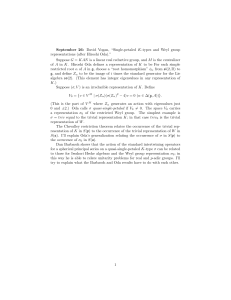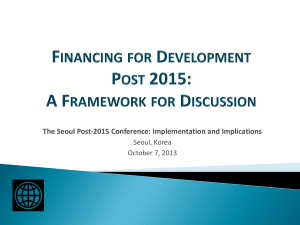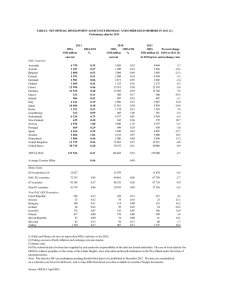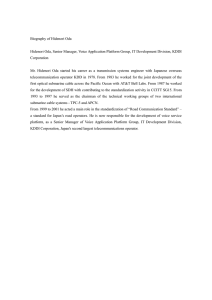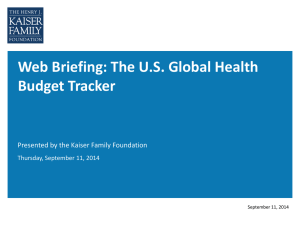Comments on "Foreign Aid Effectiveness And Selectivity: New Results"
advertisement
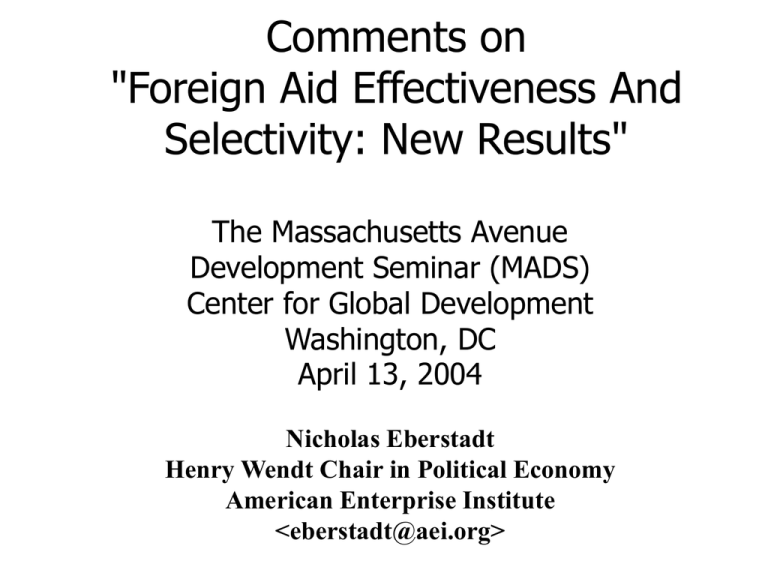
Comments on "Foreign Aid Effectiveness And Selectivity: New Results" The Massachusetts Avenue Development Seminar (MADS) Center for Global Development Washington, DC April 13, 2004 Nicholas Eberstadt Henry Wendt Chair in Political Economy American Enterprise Institute <eberstadt@aei.org> “Selectivity” and Aid, 1984-2002 There are indeed indications that the relationship between aid absorption and local policy climate in lowincome areas has been changing somewhat over time—although not necessarily in the expected directions… ODA as Percent GNI vs. Economic Freedom Rating, 1985 ODA as Percent GNI 1985 Linear (1985) 40 30 y = -1.0891x + 11.314 (-1.49) (3.01) 20 2 R = 0.0426 n = 50 10 0 0 5 10 Economic Freedom Rating Sources: The World Bank, World Development Indicators 2003 CD-ROM Gwartney, James and Robert Lawson, Economic Freedom of the World: 2003 Annual Report ODA as Percent GNI ODA as Percent GNI vs. Economic Freedom Rating, 2001 50 2001 40 Linear (2001) 30 y = -3.0479x + 24.24 (-2.52) (3.32) 20 R = 0.1076 n = 55 2 10 0 0 5 10 Economic Freedom Rating Sources: The World Bank, World Development Indicators 2003 CD-ROM Gwartney, James and Robert Lawson, Economic Freedom of the World: 2003 Annual Report The Fraser Institute, 2003. Beyond Policy Climate: Other Possible Criteria and Attendant Indicators For Measuring Aid Effectiveness • Economic Performance [per capita output, per capita exports] • Living Standards [per capita output, life expectancy] • Structural Aid Dependence [ODA/GNI, ODA/exports, ODA/imports, ODA/FDI] • Admittedly crude indicators—but relatively reliable data (cf. international poverty lines, etc.) Disaggregating Performance By Region, 1984-2002 • “Low and Middle Income Countries”: World Bank Designation for All Developing Regions • East Asia • South Asia • Latin America and the Caribbean • Middle East • Sub-Saharan Africa • Also, two “special cases” of highly “political” aid: Israel and the Russian Federation GDP Per Capita, 1984-2002 Relatively Successful Economies East Asia & Pacific Israel 10000 Latin America & Caribbean 1000 Low & middle income South Asia Year Note: Constant 1995 US Dollars Source: The World Bank, World Development Indicators 2003 CD-ROM 2002 2001 2000 1999 1998 1997 1996 1995 1994 1993 1992 1991 1990 1989 1988 1987 1986 1985 100 1984 GDP Per Capita 100000 GDP Per Capita, 1984-2002 Less Successful Economies 3000 2500 Middle East 2000 Russia 1500 Sub-Saharan Africa 1000 500 Year Note: Constant 1995 US Dollars Source: The World Bank, World Development Indicators 2003 CD-ROM 02 20 00 20 98 19 96 19 94 19 92 19 90 19 88 19 86 19 84 0 19 GDP Per Capita 3500 Net ODA, 2002 Dollars Relatively Successful Economies 100000 East Asia Net ODA Israel 10000 Latin America/Caribbean 1000 Low Middle Income South Asia 02 20 00 20 98 19 96 19 94 19 92 19 90 19 88 19 86 19 19 84 100 Year Note: Series adjusted to 2002 US Dollars by PPI deflator Sources: OECD, Geographical Distribution of Financial Flows of Aid to Recipients 1988-2002 (Paris :OECD, 2004); idem., International Development Statistics, 2002. CD-ROM Net ODA, 2002 Dollars Less Successful Economies Middle East 25000 Russia Net ODA 20000 Sub-Saharan Africa 15000 10000 5000 02 20 00 20 98 19 96 19 94 19 92 19 90 19 88 19 86 19 19 84 0 Year Note: Series adjusted to 2002 US Dollars by PPI deflator Sources: OECD, Geographical Distribution of Financial Flows of Aid to Recipients 1988-2002 (Paris :OECD, 2004); idem., International Development Statistics, 2002. CD-ROM Exports Per Capita, 2002 Dollars Relatively Successful Economies East Asia & Pacific Exports per Capita, 1984-2001 Low & middle income South Asia 1000 Latin America & Caribbean Israel 100 02 20 00 20 98 19 96 19 94 19 92 19 90 19 88 19 86 19 84 10 19 Exports Per Capita 10000 Year Source: The World Bank, World Development Indicators 2003. CD-ROM 900 800 700 600 500 400 300 200 100 0 Middle East Russia 20 02 20 00 19 98 19 96 19 94 19 92 19 90 19 88 Sub-Saharan Africa 19 86 19 84 Exports Per Capita Exports Per Capita, 2002 Dollars Less Successful Economies Year Source: The World Bank, World Development Indicators 2003. CD-ROM East Asia 25% 20% Israel 15% Latin America & Carib Low Middle Income South Asia 10% 5% 20 02 20 00 19 98 19 96 19 94 19 92 19 90 19 88 19 86 0% 19 84 Percentage of Exports ODA as a Percentage of Exports, Relatively Successful Economies Year Sources: OECD, Geographical Distribution of Financial Flows of Aid to Recipients 1988-2002 (Paris: OECD, 2004) The World Bank, World Development Indicators 2003. CD-ROM 30% 25% Middle East 20% Russia 15% Sub-Saharan Africa 10% 5% 02 20 00 20 98 19 96 19 94 19 92 19 90 19 88 19 19 19 86 0% 84 Percentage of Exports ODA as a Percentage of Exports Less Successful Economies Year Sources: OECD, Geographical Distribution of Financial Flows of Aid to Recipients 1988-2002 (Paris: OECD, 2004) OECD, International Development Statistics, 2002. CD-ROM The World Bank, World Development Indicators 2003. CD-ROM East Asia & Pacific 20 Israel 15 Latin America & Caribbean 10 5 Low & middle income 0 South Asia 19 84 19 86 19 88 19 90 19 92 19 94 19 96 19 98 20 00 20 02 Percentage of Imports ODA as Percentage of Imports Relatively Successful Economies Year Source: The World Bank, World Development Indicators 2003. CD-ROM ODA as a Percentage of Imports Less Successful Economies Middle East Russia 20 Sub-Saharan Africa 15 10 5 02 20 00 20 98 19 96 19 94 19 92 19 90 19 88 19 86 19 84 0 19 Percentage of Imports 25 Year Source: The World Bank, World Development Indicators 2003. CD-ROM FDI as a Percentage of ODA Relatively Successful Economies FDI as Percentage of ODA, 1984-2001 East Asia & Pacific Percentage of ODA 2000% Israel 1500% Latin America & Carib 1000% Low Middle Income 500% South Asia 19 84 19 86 19 88 19 90 19 92 19 94 19 96 19 98 20 00 20 02 0% Year Sources: OECD, Geographical Distribution of Financial Flows of Aid to Recipients 1988-2002 (Paris: OECD, 2004) OECD, International Development Statistics, 2002. CD-ROM The World Bank, World Development Indicators 2003. CD-ROM 380% 280% Middle East 180% Russia Sub-Saharan Africa 80% -20% 19 84 19 86 19 88 19 90 19 92 19 94 19 96 19 98 20 00 20 02 Percentage of ODA FDI as a Percentage of ODA Less Successful Economies Year Sources: OECD, Geographical Distribution of Financial Flows of Aid to Recipients 1988-2002 (Paris: OECD, 2004) OECD, International Development Statistics, 2002. CD-ROM The World Bank, World Development Indicators 2003. CD-ROM Performance Indicators for Developing World and by Region 1984 versus 2002 (regions listed in descending order of overall performance) Low/Middle Income Countries GDP Per Capita (1995 $) Life Expectancy at Birth c. 1984 972 62 c. 2002 1279 65 Per Capita Exports (2002 $) ODA as a Percentage of GNI 185 1.0% 352 0.9% ODA as a Percentage of Exports 5.6% 1.7% ODA as a Percentage of Imports 4.5% 2.9% FDI as a Percentage of ODA 47% 279% Average Economic Freedom Rating Total ODA 1984-2002 (2002 $) 4.6 1.2 trillion 6.1 Sources: OECD, Geographical Distribution of Financial Flows of Aid to Recipients 1988-2002 (Paris: OECD, 2004) OECD, International Development Statistics, 2002. CD-ROM The World Bank, World Development Indicators 2003. CD-ROM Gwartney, James and Robert Lawson, Economic Freedom of the World: 2003 Annual Report The Fraser Institute, 2003. East Asia & Pacific GDP Per Capita (1995 $) Life Expectancy at Birth c. 1984 367 66 c. 2002 1048 69 Per Capita Exports (2002 $) ODA as a Percentage of GNI 81 0.7% 332 0.5% ODA as a Percentage of Exports 3.3% 1.1% ODA as a Percentage of Imports 3.7% 1.2% FDI as a Percentage of ODA 99% 751% Average Economic Freedom Rating 6.1 6.8 Total ODA 1984-2002 (2002 $) 141 billion Sources: OECD, Geographical Distribution of Financial Flows of Aid to Recipients 1988-2002 (Paris: OECD, 2004) OECD, International Development Statistics, 2002. CD-ROM The World Bank, World Development Indicators 2003. CD-ROM Gwartney, James and Robert Lawson, Economic Freedom of the World: 2003 Annual Report The Fraser Institute, 2003. South Asia GDP Per Capita (1995 $) Life Expectancy at Birth c. 1984 270 56 c. 2002 486 63 Per Capita Exports (2002 $) ODA as a Percentage of GNI 28 1.5% 66 1.0% ODA as a Percentage of Exports 21.9% 9.4% ODA as a Percentage of Imports 13.1% 5.1% FDI as a Percentage of ODA 2% 47% Average Economic Freedom Rating Total ODA 1984-2002 (2002 $) 4.6 5.8 139 billion Sources: OECD, Geographical Distribution of Financial Flows of Aid to Recipients 1988-2002 (Paris: OECD, 2004) OECD, International Development Statistics, 2002. CD-ROM The World Bank, World Development Indicators 2003. CD-ROM Gwartney, James and Robert Lawson, Economic Freedom of the World: 2003 Annual Report The Fraser Institute, 2003. Israel GDP Per Capita (1995 $) Life Expectancy at Birth c. 1992 14,259 76 c. 2002 17,068 79 Per Capita Exports (2002 $) ODA as a Percentage of GNI 4383 3.2% 6611 0.8% ODA as a Percentage of Exports 10.6% 1.9% ODA as a Percentage of Imports 7.5% 0.3% FDI as a Percentage of ODA 29% 428% Economic Freedom Rating Total ODA 1984-2002 (2002 $) 4.2 29 billion 6.5 Sources: OECD, Geographical Distribution of Financial Flows of Aid to Recipients 1988-2002 (Paris: OECD, 2004) OECD, International Development Statistics, 2002. CD-ROM The World Bank, World Development Indicators 2003. CD-ROM Gwartney, James and Robert Lawson, Economic Freedom of the World: 2003 Annual Report The Fraser Institute, 2003. Latin America & the Caribbean GDP Per Capita (1995 $) Life Expectancy at Birth c. 1984 3391 66 c. 2002 4052 71 Per Capita Exports (2002 $) ODA as a Percentage of GNI 423 0.5% 771 0.3% ODA as a Percentage of Exports 2.1% 1.3% ODA as a Percentage of Imports 2.1% 1.2% FDI as a Percentage of ODA 162% 1356% Average Economic Freedom Rating 4.3 Total ODA 1984-2002 (2002 $) 101 billion Sources: 6.4 OECD, Geographical Distribution of Financial Flows of Aid to Recipients 1988-2002 (Paris: OECD, 2004) OECD, International Development Statistics, 2002. CD-ROM The World Bank, World Development Indicators 2003. CD-ROM Gwartney, James and Robert Lawson, Economic Freedom of the World: 2003 Annual Report The Fraser Institute, 2003. Middle East GDP Per Capita (1995 $) Life Expectancy at Birth c. 1984 1843 62 c. 2002 1988 69 Per Capita Exports (2002 $) ODA as a Percentage of GNI 728 N/A 672 0.7% ODA as a Percentage of Exports 3.3% 1.7% ODA as a Percentage of Imports 3.0% 2.7% FDI as a Percentage of ODA 172% 164% Average Economic Freedom Rating Total ODA 1984-2002 (2002 $) 5.2 74 billion 6.3 Sources: OECD, Geographical Distribution of Financial Flows of Aid to Recipients 1988-2002 (Paris: OECD, 2004) OECD, International Development Statistics, 2002. CD-ROM The World Bank, World Development Indicators 2003. CD-ROM Gwartney, James and Robert Lawson, Economic Freedom of the World: 2003 Annual Report The Fraser Institute, 2003. Russia GDP Per Capita (1995 $) c. 1992 2967 c. 2002 2609 Life Expectancy at Birth 67 66 Per Capita Exports (2002 $) 570 776 ODA as a Percentage of GNI ODA as a Percentage of Exports ODA as a Percentage of Imports FDI as a Percentage of ODA 0.5% 6.2% 2.6% 15% 0.4% 1.2% 1.3% 190% Economic Freedom Rating Total ODA 1992-2002 (2002 $) 4.1 50 billion 5.0 Sources: OECD, Geographical Distribution of Financial Flows of Aid to Recipients 1988-2002 (Paris: OECD, 2004) OECD, International Development Statistics, 2002. CD-ROM The World Bank, World Development Indicators 2003. CD-ROM Gwartney, James and Robert Lawson, Economic Freedom of the World: 2003 Annual Report The Fraser Institute, 2003. Sub-Saharan Africa GDP Per Capita (1995 $) Life Expectancy at Birth c. 1984 621 49 c. 2002 575 46 Per Capita Exports (2002 $) ODA as a Percentage of GNI 188 4.9% 168 4.6% ODA as a Percentage of Exports 12.9% 16.4% ODA as a Percentage of Imports 12.2% 11.0% FDI as a Percentage of ODA 13% 74% Average Economic Freedom Rating Total ODA 1984-2002 (2002 $) 4.5 5.7 319 billion Sources: OECD, Geographical Distribution of Financial Flows of Aid to Recipients 1988-2002 (Paris: OECD, 2004) OECD, International Development Statistics, 2002. CD-ROM The World Bank, World Development Indicators 2003. CD-ROM Gwartney, James and Robert Lawson, Economic Freedom of the World: 2003 Annual Report The Fraser Institute, 2003. Preliminary Conclusions • • • • • • Did the policy climate in recipient low-income areas improve between 1984 and 2002? Very clearly, yes—improvement was marked and general. Did aid “selectivity” and aid “effectiveness” contribute positively to this outcome? The answer to this question is not at all self-evident. For low-income, aid-receiving areas as a whole, trends were generally positive for economic performance (up), living standards (up), and structural aid dependence (down). But performance “story lines” varied tremendously between regions—with the most heavily aid-dependent areas characterized by measured stagnation, or retrogression, in economic performance and living standards. How to explain the striking negative association among regions between high aid levels and poor trends in economic performance and living standards: Measurement error? “Neighborhood effects”? Independent influence of structural aid dependence? Some combination? Other factors? Perhaps surprisingly, markedly different performance records for highly “political” aid in different settings: the “story line” for Russia looks rather disappointing, while the “story line” appears more promising.
